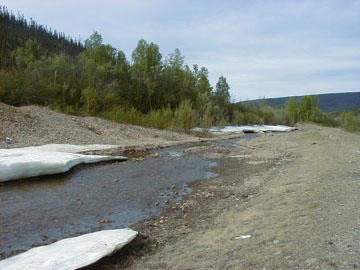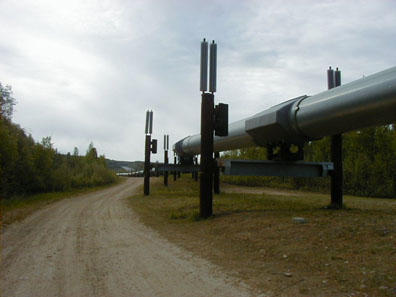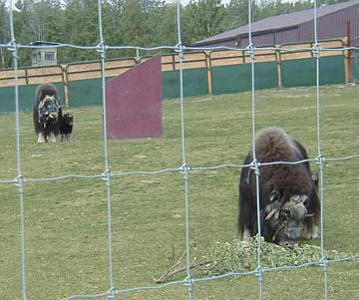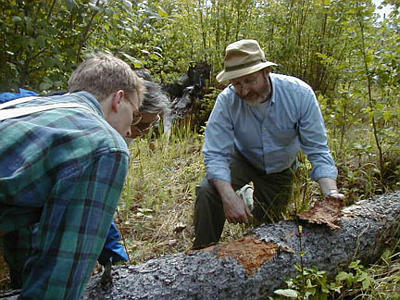8 June, 1999
Tuesday, June 8, 1999
Hi all! We did so much today, I can't even
remember it all! I know
the day started by me having to dig out the long johns for
a trip to
CRREL's ( U.S. Army's Cold Regions Research and
Engineering Laboratory)
permafrost tunnel, which was pretty incredible. Permafrost
is ground that
is permanently frozen, and while in Fairbanks permafrost
areas are
scattered around (discontinuous permafrost), up above the
Arctic Circle -
such as in Barrow - ALL the ground is permafrost -
sometimes for more than
1,000 meters thick! Matthew Sturm, a snow scientist with
CRREL in
Fairbanks, gave us a thorough tour of the tunnel's main
features, including
seeing the underside of ice lenses in the soil and the
preserved remains of
a Steppe Bison that died over 30,000 years ago. In the
summer, they must
refrigerate the tunnel, and they try to keep the lights on
inside for as
short a time as possible. I will write more about
permafrost and the tunnel
later, but I want to get down on paper (not really paper,
I guess!) what
else we did before I forget.
We went from the permafrost tunnel to the monument
of Felix Pedro
(his nickname), who first discovered gold near Fairbanks.
The significant
part of this trip is that there was still snow on the
ground here! Weather
in Fairbanks has been consistently hitting 70 and above
for several days,
so it was very surprising to see this snow around the
creek.
We then went to the Trans-Alaska Pipeline, which
pipes oil from
Prudhoe Bay on the Arctic Coast (east of Barrow) all the
way to Valdez in
Southcentral Alaska. I must write more about that too! I
am in a bit of a
time crunch write now, since although the date says
"TUESDAY" it is
actually Wednesday and I need to go catch a plane to
Barrow! Before I sign
off, I must mention that we also went to LARS, which is
the University of
Fairbanks Large Animal Research Station, where I learned
about musk oxen,
caribou, and reindeer.
The remainder of the afternoon was spent at a LTER (Long
Term Ecological
Research) site in a boreal forest near the Tanana River
Floodplains, where
Dr. Glenn Juday from UAF (University of Alaska Fairbanks)
was kind enough
to let Renee and I tag along as introduced the area to a
couple of his new
graduate students. It was very interesting to learn about
his research and
future research opportunities of that area.
Well, it is 4:30 and my plane leaves at 5:19 so I
must be off! I
will fill in the details much better when I next reach a
computer (possibly
tonight). I have not yet had access to my e-mail, but I
think I will be
able to read it by tomorrow in Barrow, in case anyone has
sent any messages
back to me! Hope all is well with you all! Michele
Hauschulz
____________________________________________________________________
Get your own FREE, personal Netscape WebMail account today at http://webmail.netscape.com.

Matthew Sturm from CRREL (Cold Regions Research and Engineering Laboratory) at the entrance of the Permafrost Tunnel.

Remnants of the ice that covered Goldstream Creek a few months ago.

Fairbanks is approximately the halfway point of the Trans-Alaska Oil Pipeline that snakes its way across 800 miles of Alaska from Prudhoe Bay on the north slope to deliver oil to tankers waiting in the port city of Valdez.

Dr. Pam Groves details the different adaptations that caribou and muskox have for surviving in the high Arctic and describes the differences between caribou and domesticated reindeer, which live in a mixed herd at the Large Animal Research Station.

Muskox calves are born in early spring and stay close to their mothers for over a year. Muskox at LARS are used to investigate aspects of behavior, nutritional physiology, energetics, and wool production.

Glenn Juday of the Forest Sciences Department of the University of Alaska Fairbanks explains the life history of two species of wood-boring beetles found in the trees of this section of the Long Term Ecological Research station at Bonanza Creek that burned in 1983.
Contact the TEA in the field at
.
If you cannot connect through your browser, copy the
TEA's e-mail address in the "To:" line of
your favorite e-mail package.
|
